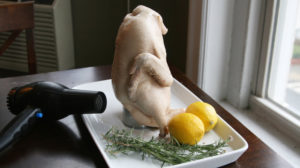The joy of a frozen turkey is that you can buy it well in advance of your holiday and eat it later—as long as you defrost it safely.
If you defrost your turkey wrong? Well, you could be inviting bacteria to join you for dinner (and Staphyloccus aureus, Salmonella, Listeria monocytogens, Clostridium perfingens, or Enteropathoginec Escherichia coli just don’t fit well on a place card).
I scoured the internet in search of the best and worst ways to go about defrosting your Butterball. Here are your answers:
The 3 right ways to defrost a turkey
1. In the fridge—the slowest, but also the safest and laziest option if you plan ahead. How long does it take? About 24 hours for each 4-5 pounds of turkey in a fridge set at 40 degrees or below (see Temperature Danger Zone for why this is so important).Make sure you put your bird in a pan to catch any drips, but here are the thawing times according to the USDA:
- 4-12 pound turkey: 1 to 3 days
- 12-16 pound turkey: 3 to 4 days
- 16-20 pound turkey: 4 to 5 days
- 20-24 pound turkey: 5 to 6 days
The USDA also says a fridge-thawed turkey can remain in the refrigerator for 1 or 2 days before you
cook it.
2. In a cold water bath—medium fast, but will take some effort on your part. How long does it take? About 30 minutes per pound, but you’ve got to babysit to make sure the turkey stays at a safe temp.
Note: keep your turkey in its original wrap or put the turkey in a leak-proof bag (with as little air in the bag as possible) to keep water out—your turkey will turn out gross if it gets watery. The other reason for bagging is to prevent cross contamination from any turkey juice leaks.
Submerge the bird in ice cold water (you’re aiming for 40 degrees) and change it every 30 minutes (again, keeping an eye on the temperature). Here are the times:
- 4-12 pound turkey: 2-6 hours
- 12-16 pound turkey: 6-8 hours
- 16-20 pound turkey: 8-10 hours
- 20-24 pound turkey: 10-12 hours
According to the USDA, you should cook the turkey immediately. Now, it should be noted, while the government says you can defrost in water, not everyone agrees.
3. In the microwave—the fastest, as long as it fits and you’re desperate. Follow your microwave’s instructions, but cook it immediately after.
Why desperate? You know how microwaves are—even when you defrost they can partially cook the food. This means at least some of the meat is in the temperature danger zone where bacteria can sprout up. It’ll work in a pinch, but if your bird is small enough to fit in the micro, you should probably use one of the other, better, methods.
How not to defrost a turkey
- Leaving it on your counter, porch, or any other room in your house (and no, don’t put it in your garage either). Uncooked meat left at room temperature—or fluxuating temps [we’re looking at you, garage defroster])—for more than a few hours can start to grow bacteria.
- In hot/warm water. T
 his actually worse that leaving it on the counter because the meat will get warmer than air temp (the bacteria will be thrilled to multiply even more quickly though). No matter how quickly you do it, it’s just not safe.
his actually worse that leaving it on the counter because the meat will get warmer than air temp (the bacteria will be thrilled to multiply even more quickly though). No matter how quickly you do it, it’s just not safe. - With a hair dryer. The same rules apply here as they did for using warm water. It’s not safe because you’re getting the meat smack dab into the temperature danger zone. (Image: NPR)
If you missed your defrost window, cook it frozen!
No, for real—the internet says you can do this. The Kitchn.com says it’ll take 50 percent longer to cook, but you totally can. Better to take an extra few hours to cook than risk having food poisoning, if you ask me. They offer a printable recipe so head on over.
Who to call for help
The Butterball Turkey Talk-Line® is always a popular resource. It’s been around for more than 30 years and is staffed with “professionally trained turkey experts” to help answer your bird-related questions. You can call them by dialing 1-800-288-8372.
You can also chat with them, shoot them an email, or text them! The hours and links to their resources can be found right here on their website.
Good luck, and happy holidays.
Top image courtesy of Flickr user Foodista.


